Three-Dimensional and Two-Dimensional Stability Analysis of Bentonite Slurry Trenches Using a Shear Strength Reduction Technique and Limit Equilibrium Methods
Abstract
:Featured Application
Abstract
1. Introduction
2. Description of the Analysed Problem
2.1. Shear Strength Reduction Technique
- In 2D (FLAC2D v. 7.0 and RS2 v. 11.0): X × Z = 20 m × 20 m;
- In 3D (FLAC3D v. 7.0 and RS3 v. 4.0): X × Y × Z = 10 m × 10 m (up to 34 m) × 20 m.
- In 2D: width × depth = 1 m (or 2 m) × 10 m;
- In (3D): width × length × depth = 1 m (or 2 m) × 6 m × 10 m.
2.2. Bell–Washbourne Method
3. Stability of Bentonite Slurry with Stratum C3
Discussion of Calculation Results
4. Conclusions
Author Contributions
Funding
Institutional Review Board Statement
Informed Consent Statement
Data Availability Statement
Conflicts of Interest
References
- Budleigh, J.K. Trench Excavation and Support, 1st ed.; Thomas Telford: London, UK, 1989; pp. 26–42. [Google Scholar] [CrossRef]
- McDonald, Y. Trench Support Best Practice Guideline; Christchurch City Council: Christchurch, New Zealand, 2017; pp. 1–11. [Google Scholar]
- Whitlow, R. Basic Soil Mechanics, 2nd ed.; (Translated to Vietnamese, language); John Willey & Sons, Inc.: New York, NY, USA; Vietnamese Education Publisher: Ha Noi, Vietnam, 1999; Volume 2, pp. 21–100. [Google Scholar]
- Kế, N.B. Thiết kế và thi công hố móng sâu, 2nd ed.; Xây Dựng Hà Nội: Hà Nội, Hanoi, Vietnam, 2010; pp. 33–66. (In Vietnamese) [Google Scholar]
- Terzaghi, K.; Peck, R.B.; Mesri, G. Soil Mechanics in Engineering Practice, 3rd ed.; A Wiley-Interscience Publication John Wiley & Sons, Inc.: New York, NY, USA; Chichester, UK; Brisbane, Australia; Toronto, ON, Canada; Singapore, 1996; pp. 241–289. [Google Scholar]
- Piaskowski, A.; Kowalewski, Z. Application of Thixotropic Clay Suspensions for Stability of Vertical Sides of Deep Trenches without Strutting. In Proceedings of the 6th International Conference on Soil Mechanics and Foundation Engineering, Montréal, Canada, 8–15 September 1965; pp. 526–529. [Google Scholar]
- Washbourne, J. The three-dimensional stability analysis of diaphragm wall excavations. Ground Eng. 1984, 17, 24–29. [Google Scholar]
- Tsai, J.S.; Chang, J.C. Three-dimensional stability analysis for slurry-filled trench wall in cohesionless soil. Can. Geotech. J. 1996, 33, 798–808. [Google Scholar] [CrossRef]
- Tamano, T.; Fukui, S.; Suzuki, H.; Ueshita, K. Stability of slurry trench excavation in soft clay. Soils Found. 1996, 36, 101–110. [Google Scholar] [CrossRef] [PubMed]
- Fox, P.J. Analytical Solutions for Stability of Slurry Trench. J. Geotech. Geoenviron. Eng. 2004, 130, 749–758. [Google Scholar] [CrossRef]
- Brząkała, W.; Gorska, K. On safety of slurry-wall trenches. Stud. Geotech. Mech. 2008, 30, 199–206. [Google Scholar]
- Ding, Y.C.; Wang, J.H. Numerical modelling of ground response during diaphragm wall construction. J. Shanghai Jiaotong Univ. Sci. 2008, 13, 385–390. [Google Scholar] [CrossRef]
- Li, Y.-C.; Pan, Q.; Cleall, P.J.; Chen, Y.-M.; Ke, H. Stability Analysis of Slurry Trenches in Similar Layered Soils. J. Geotech. Geoenviron. Eng. 2013, 139, 2104–2109. [Google Scholar] [CrossRef]
- Han, C.; Chen, J.; Wang, J.; Xia, X. 2D and 3D stability analysis of slurry trench in frictional/cohesive soil. Appl. Phys. Eng. 2013, 14, 94–100. [Google Scholar] [CrossRef]
- Zhang, F.; Gao, Y.F.; Leshchinsky, D.; Zhu, D.S.; Lei, G.H. Three-dimensional stability of slurry-supported trenches: End effects. Comput. Geotech. 2016, 74, 174–187. [Google Scholar] [CrossRef]
- Xiao, H.; Sun, Y. Stability analysis of slurry trenches under surcharge in soft soils. In Proceedings of the 7th International Conference on Energy, Environment and Sustainable Development (ICEESD), Shenzhen, China, 30–31 March 2018; Volume 163, pp. 1004–1009. [Google Scholar]
- Li, W.; Zhang, C. Stability Analysis of a Slurry Trench in Cohesive-Frictional Soils. Open Geosci. 2019, 11, 888–900. [Google Scholar] [CrossRef]
- Wang, H.; Huang, M. Upper bound stability analysis of slurry-supported trenches in layered soils. Comput. Geotech. 2020, 122, 103554. [Google Scholar] [CrossRef]
- Wang, H.; Huang, M.; Chian, S.C. Three-dimensional trench stability in non-uniform undrained clay with discretization-based kinematic analysis. Comput. Geotech. 2021, 135, 104166. [Google Scholar] [CrossRef]
- Huang, F.; Wang, Y.; Xu, Y.; Pan, Q.; Wang, D. Three-dimensional Stability Analysis of Slurry Trench Based on Mohr-Coulomb Nonlinear Failure Criterion. KSCE J. Civ. Eng. 2022, 26, 5038–5048. [Google Scholar] [CrossRef]
- Xu, Q.; Xie, J.; Sun, Z.; Lu, L.; Yu, H. Stability Analysis of Trench Wall for Diaphragm Wall in Ultra-Deep Circular Foundation Pit: A Comprehensive Investigation. Appl. Sci. 2023, 13, 12037. [Google Scholar] [CrossRef]
- Zienkiewicz, O.C.; Humpheson, C.; Lewis, R.W. Associated and non-associated visco-plasticity and plasticity in soil mechanics. Geotechnique 1975, 25, 671–689. [Google Scholar] [CrossRef]
- Dawson, E.M.; Roth, W.H.; Drescher, A. Slope stability analysis by strength reduction. Geotechnique 1999, 49, 835–840. [Google Scholar] [CrossRef]
- Cała, M.; Flisiak, J. Complex geology slope stability analysis by shear strength reduction. In FLAC and Numerical Modeling in Geomechanics 2003, Proceedings of the 3rd International FLAC Symposium, Sudbury, ON, Canada, 22–24 October 2003; Andrieux, P., Brummer, R., Detournay, C., Hart, R., Eds.; CRC Press: Boca Raton, FL, USA, 2003. [Google Scholar]
- Cała, M. Convex and concave slope stability analyses with numerical methods. Arch. Min. Sci. 2007, 52, 75–89. [Google Scholar]
- Cała, M.; Stopkowicz, A.; Cyran, K.; Kowalski, M.; Blajer, M.; d’Obyrn, K. Stability analysis of underground mining openings with complex geometry. Stud. Geotech. Mech. 2016, 38, 25–32. [Google Scholar] [CrossRef]
- Cała, M.; Cyran, K.; Kowalski, M.; Wilkosz, P. Influence of the anhydrite interbeds on a stability of the storage caverns in the Mechelinki salt deposit (Northern Poland). Arch. Min. Sci. 2018, 63, 1007–1025. [Google Scholar]
- Adamczyk, J.; Cała, M.; Flisiak, J.; Kolano, M.; Kowalski, M. Slope stability analysis of waste dump in Sandstone Open Pit Osielec. Stud. Geotech. Mech. 2013, 35, 3–17. [Google Scholar] [CrossRef]
- Cała, M.; Kowalski, M.; Stopkowicz, A. The three-dimensional (3D) numerical stability analysis of Hyttemalmen open-pit. Arch. Min. Sci. 2014, 59, 609–620. [Google Scholar] [CrossRef]
- Jakóbczyk, J.; Cała, M.; Stopkowicza, A. What were the reasons for the rapid landslide occurrence in “Piaseczno” open pit?—Analysis of the landslide process. Stud. Geotech. Mech. 2015, 37, 25–35. [Google Scholar] [CrossRef]
- Cała, M.; Cyran, K.; Jakóbczyk, J.; Kowalski, M. The challenges of open-pit mining in the vicinity of the salt dome (Bełchatów Lignite Deposit, Poland). Energies 2020, 13, 1913. [Google Scholar] [CrossRef]
- Rocscience, RS2 Version 11.012 2D Geotechnical Finite Element Analysis Rocscience, Tutorials. 2012. Available online: https://www.rocscience.com/software/rs2 (accessed on 14 February 2023).
- Rocscience, RS3 Tutorials. Available online: https://www.rocscience.com/help/rs3/tutorials (accessed on 14 February 2023).
- Itasca Consulting Group. FLAC2D-Fast Lagrangian Analysis of Continua, Ver. 7.0 User’s Manual; Itasca Consulting Group: Minneapolis, MN, USA, 2011. [Google Scholar]
- Itasca Consulting Group. FLAC Theory and Background—Itasca Software Documentation. Available online: https://docs.itascacg.com/itasca900/flac3d/docproject/source/theory/theory.html?node2317 (accessed on 11 October 2023).
- Công ty cổ phần tư vấn thiết kế tổng hợp. Báo cáo khảo sát địa chất công trình: Khách sạn Monial—Thành Phố Huế; Công ty cổ phần tư vấn thiết kế tổng hợp: Ha Noi, Vietnam, 2005. (In Vietnamese) [Google Scholar]
- Công ty cổ phần tư vấn thiết kế tổng hợp. Báo cáo khảo sát địa chất công trình: Viện quy hoạch xây dựng Thừa Thiên Huế; Công ty cổ phần tư vấn thiết kế tổng hợp: Ha Noi, Vietnam, 2007. (In Vietnamese) [Google Scholar]
- Công ty Tư vấn xây dựng số 1 Thừa Thiên Huế. Thuyết minh địa chất: Công ty Cổ phần Vật liệu Xây dựng Huế; Công ty Tư vấn xây dựng số 1 Thừa Thiên Huế: Ha Noi, Vietnam, 2010. (In Vietnamese) [Google Scholar]
- Công ty Tư vấn xây dựng số 1 Thừa Thiên Huế. Thuyết minh địa chất: Bệnh viện Ngoại khoa Quốc tế Huế; Công ty Tư vấn xây dựng số 1 Thừa Thiên Huế: Ha Noi, Vietnam, 2011. (In Vietnamese) [Google Scholar]
- Công ty Tư vấn xây dựng số 1 Thừa Thiên Huế. Thuyết minh địa chất: Trụ sở Công An Phường Phú Hiệp; Công ty Tư vấn xây dựng số 1 Thừa Thiên Huế: Ha Noi, Vietnam, 2014. (In Vietnamese) [Google Scholar]
- Công ty Tư vấn xây dựng số 1 Thừa Thiên Huế. Báo cáo khảo sát địa chất công trình: VỸ DẠ Boutique Resort; Công ty Tư vấn xây dựng số 1 Thừa Thiên Huế: Ha Noi, Vietnam, 2016. (In Vietnamese) [Google Scholar]
- Tường, L.T.C. Nghiên cứu dự báo những vấn đề địa chất công trình đối với hố móng sâu trên các kiểu cấu trúc nền khu vực thành phố Huế và đề xuất giải pháp ổn định hố móng. Master’s Thesis, Hue Science University, Hue, Vietnam, 2009. [Google Scholar]
- Thảo, P.T. Nghiên cứu các kiểu cấu trúc nền đất yếu khu vực thành phố Huế và đề xuất giải pháp kỹ thuật cải tạo hợp lý. Master’s Thesis, Hue Science University, Hue, Vietnam, 2004. [Google Scholar]
- Tiến, N.Đ.; Bảo, N.Đ. Đặc điểm địa chất khu vực thành phố Huế, Thừa Thiên Huế. 2002. Available online: https://csdlkhoahoc.hueuni.edu.vn/index.php/topic/index/user/95/page/2 (accessed on 1 June 2024).
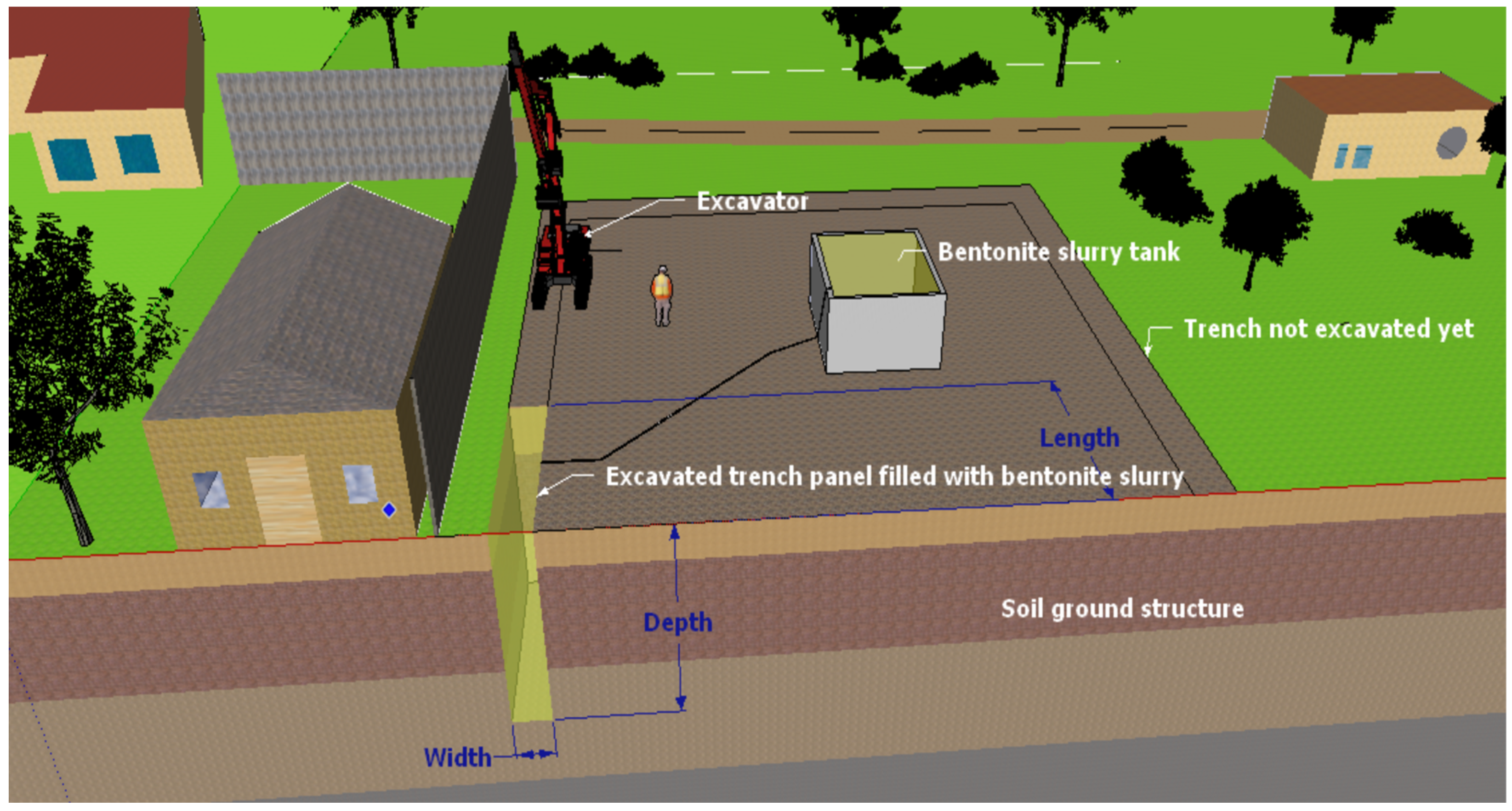



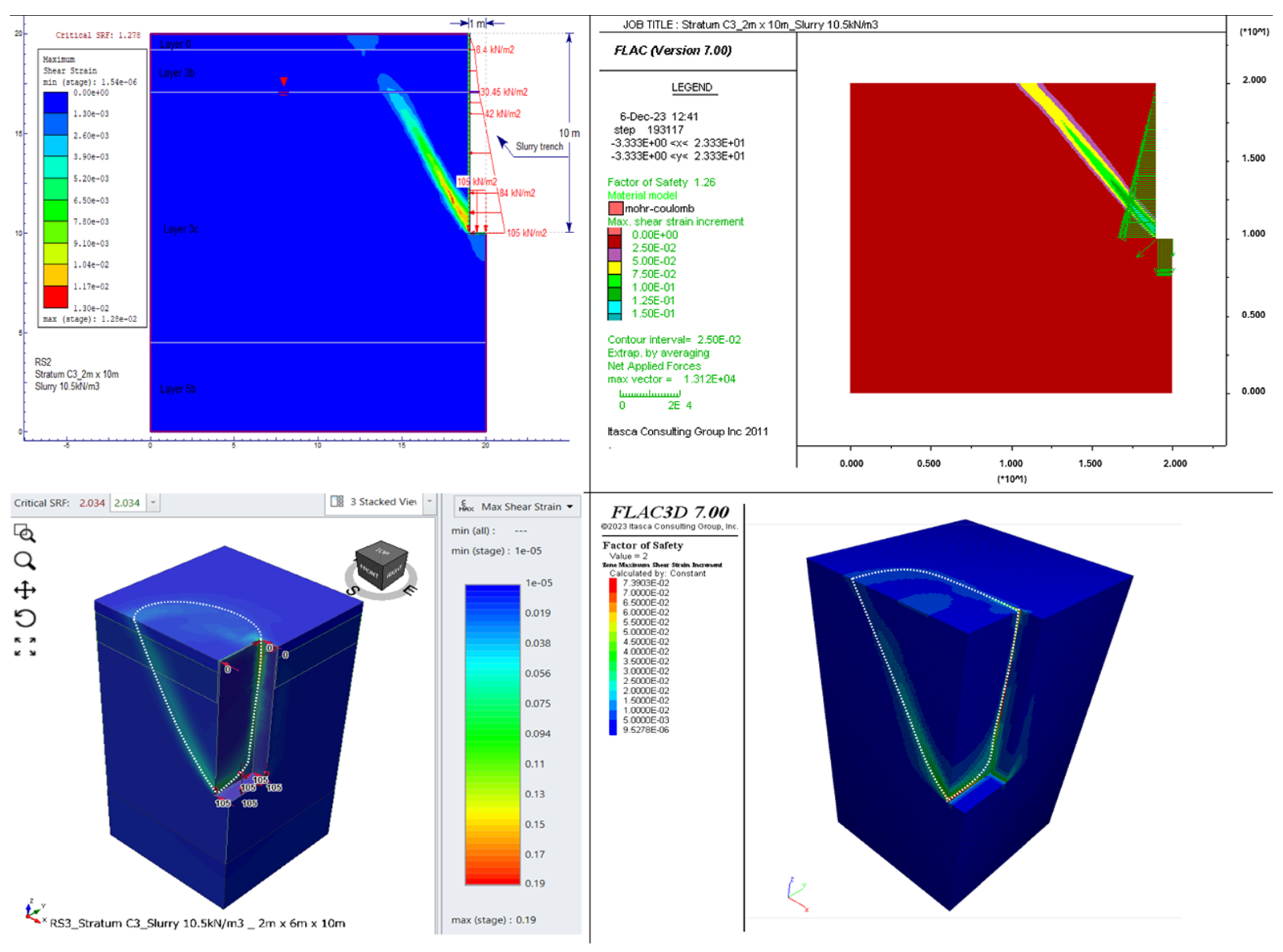

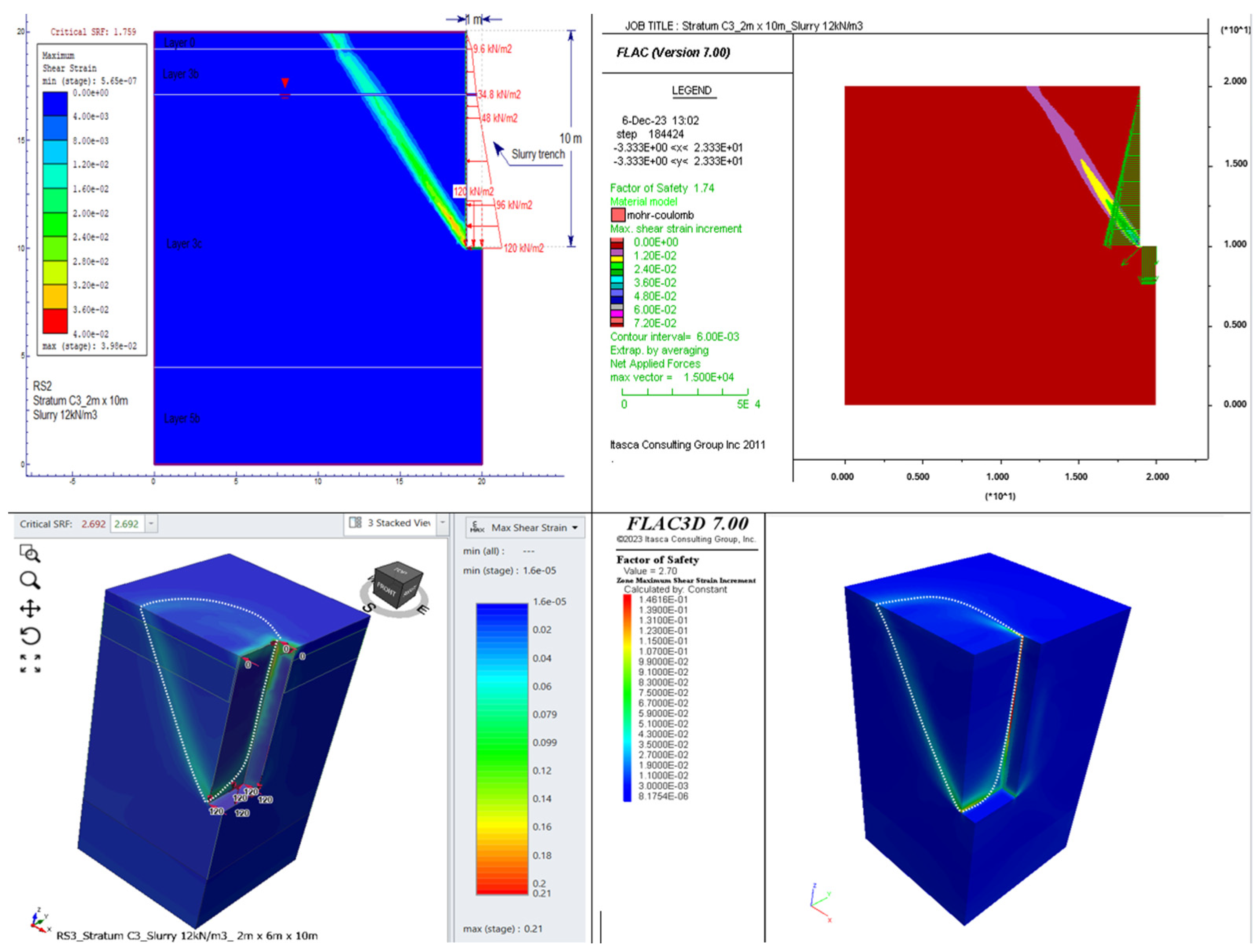

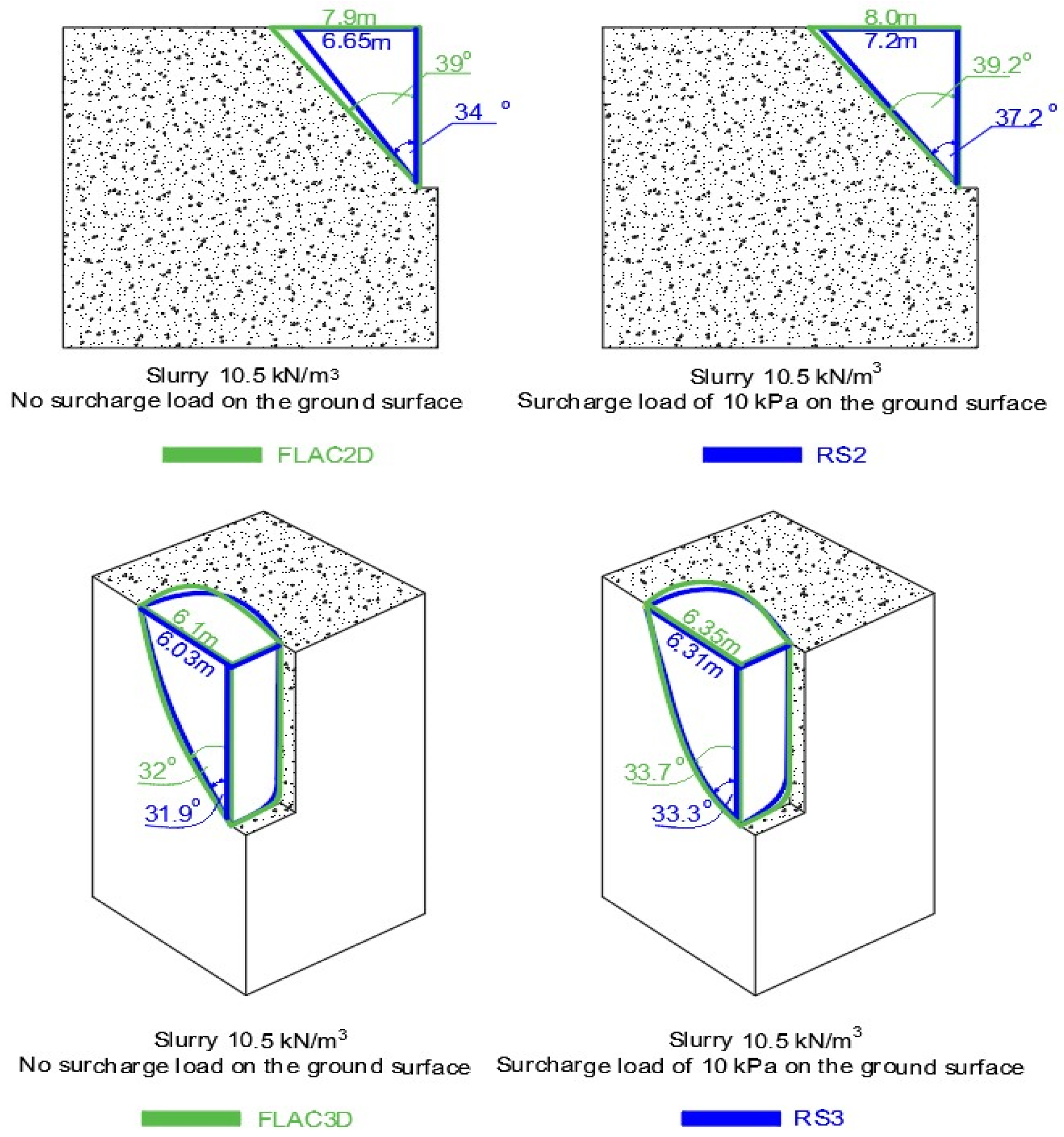
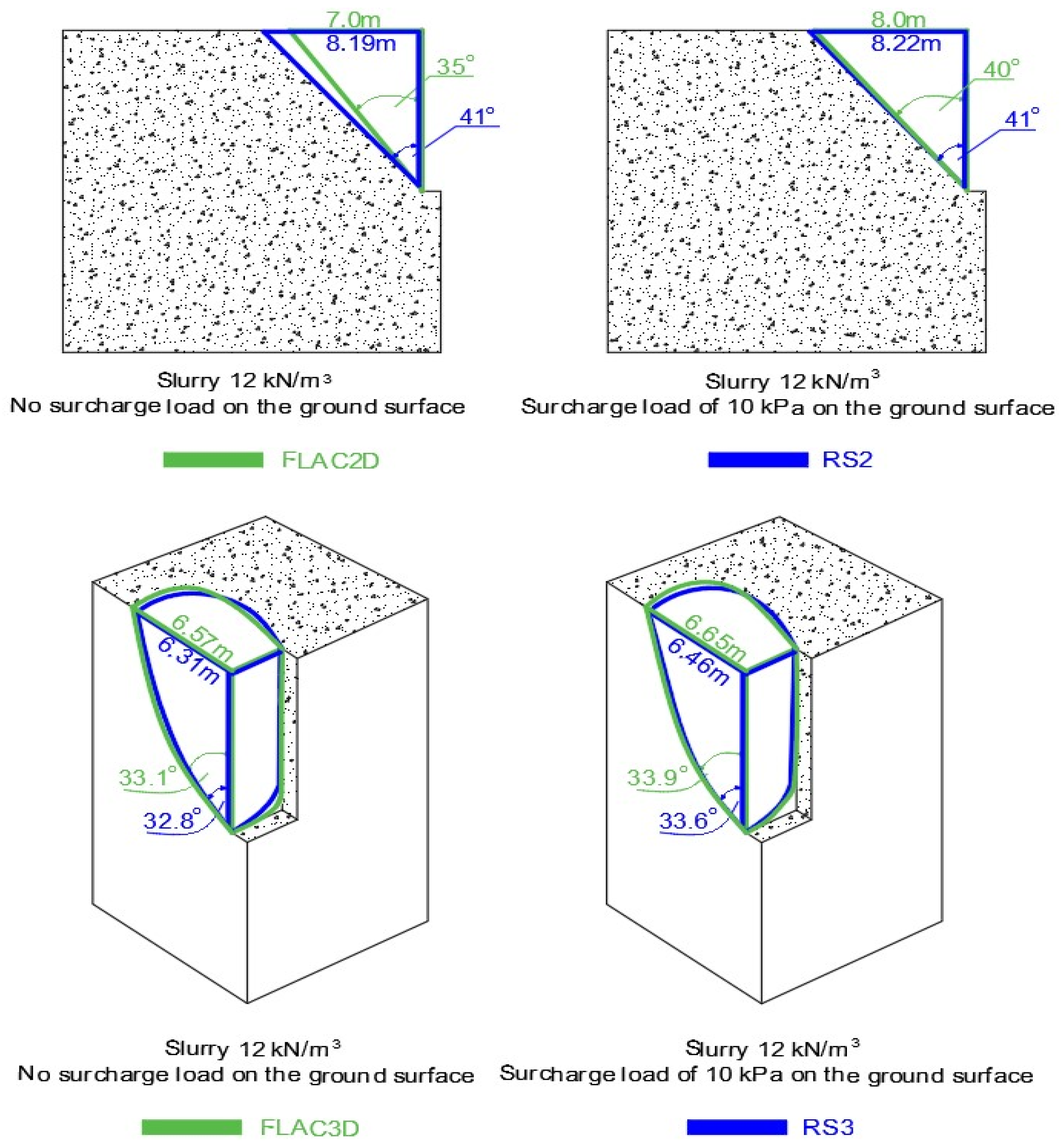


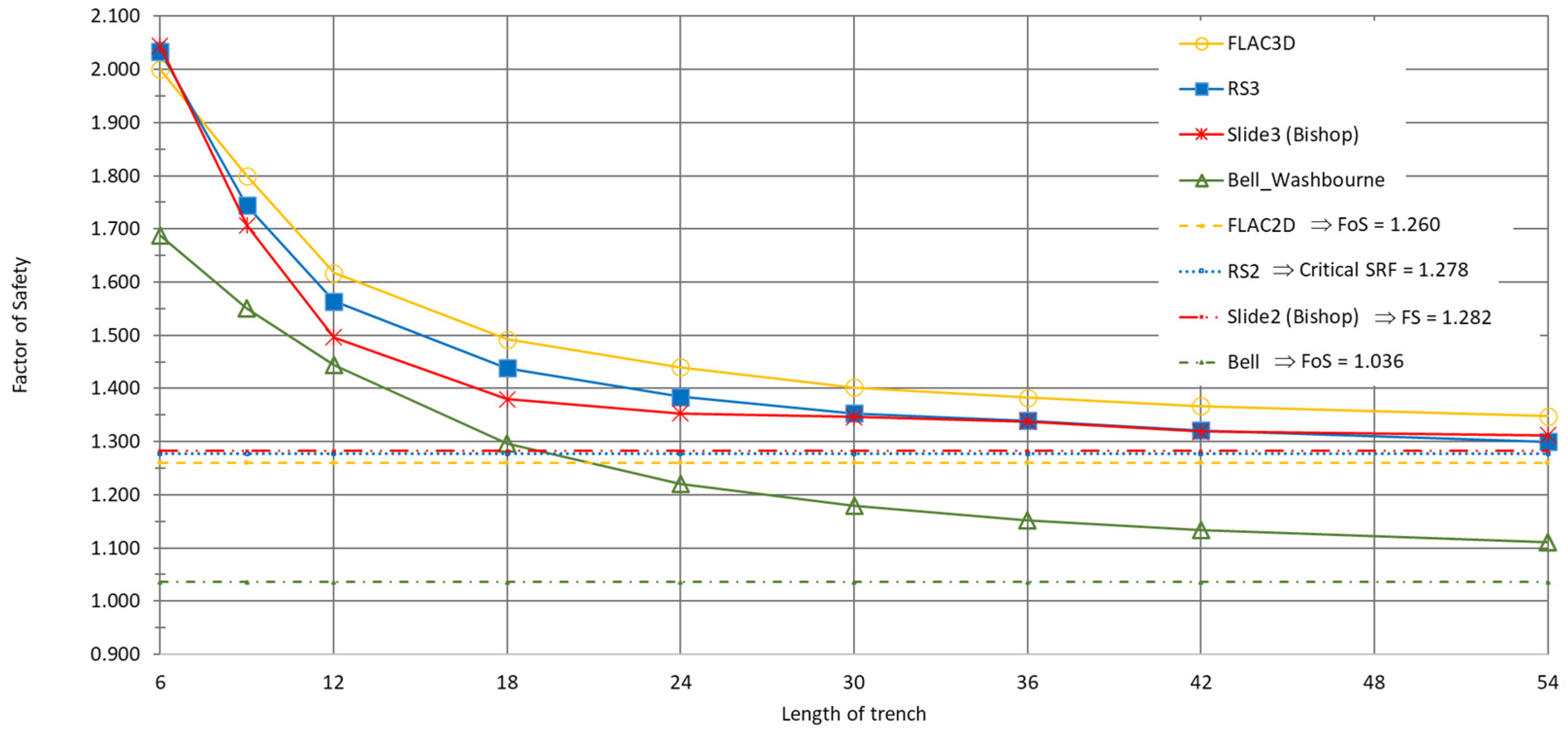
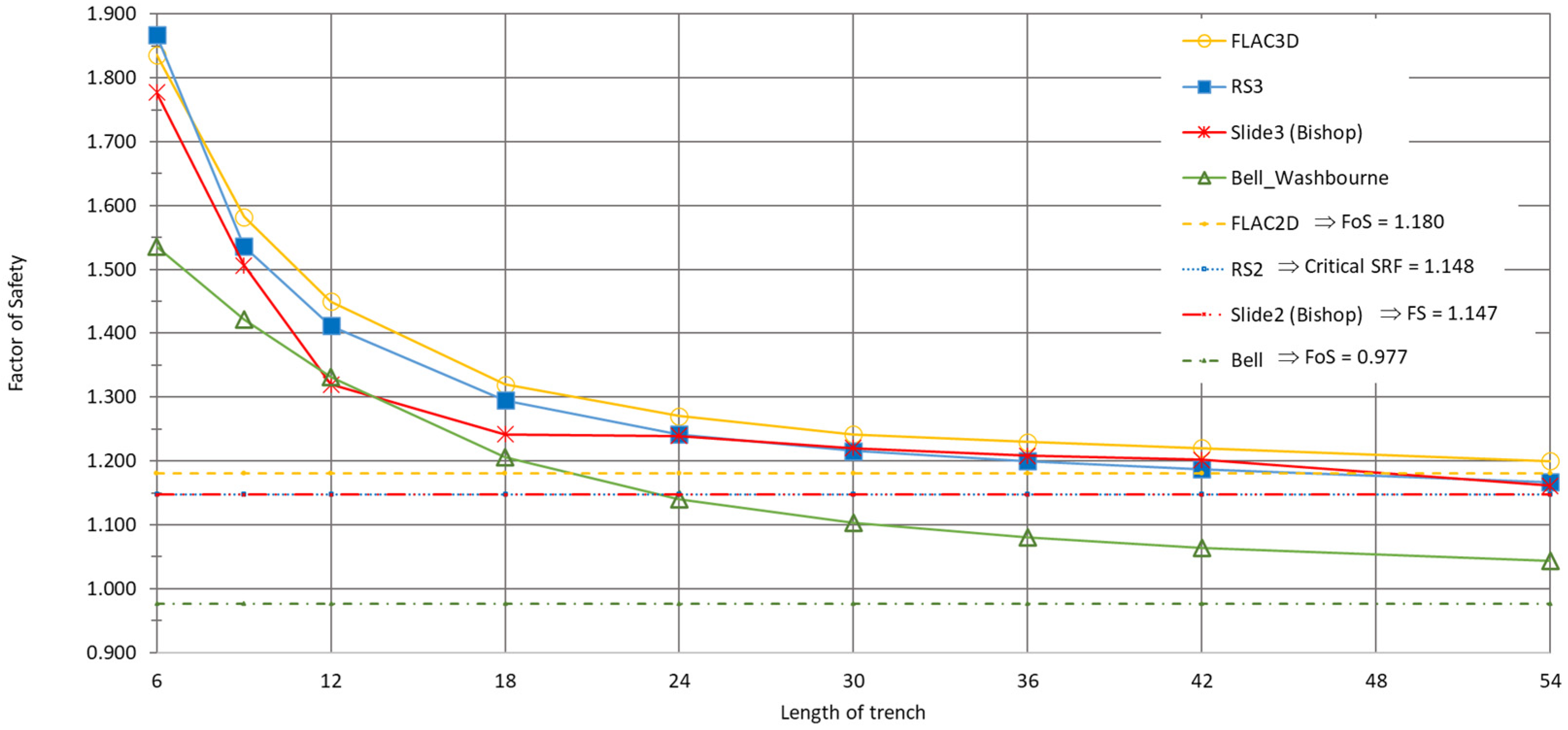
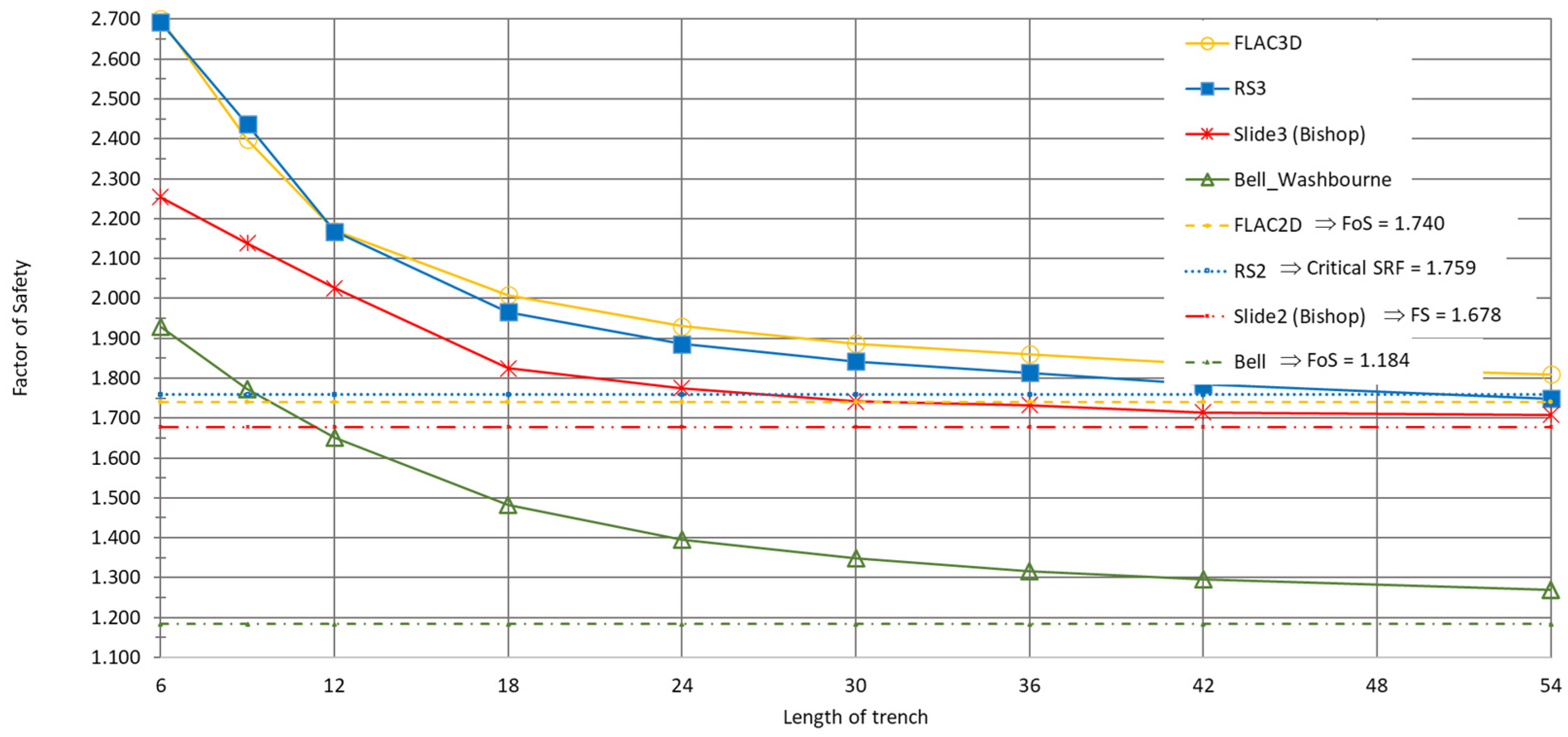

| Layer | Thickness from the Surface, m | Young Modulus, MPa | Cohesion kPa | Friction, Deg | Number of Blows, SPT Test | ||
|---|---|---|---|---|---|---|---|
| Sand | 0.8 | 10 | 15.03 | 17.93 | 0 | 28.3 | 5 |
| Sandy clay | 2.9 | 8.32 | 16.35 | 20.08 | 14.73 | 13.6 | 11 |
| Sand | 15.5 | 34 | 16.93 | 20.20 | 0 | 31.5 | 15 |
| Sandy clay | 6 | 10.782 | 20.20 | 20.13 | 11.28 | 17.7 | 14 |
| Trench Size | Slurry: γs = 10.5 kN/m3 | |||
|---|---|---|---|---|
| Width × Depth | No surcharge load | Surcharge load 10 kPa | ||
| m × m | RS2 | FLAC2D | RS2 | FLAC2D |
| 1 × 10 | 1.32 | 1.31 | 1.18 | 1.19 |
| 2 × 10 | 1.278 | 1.26 | 1.148 | 1.18 |
| Width × Length × Depth | RS2 | FLAC2D | RS2 | FLAC2D |
| 1 × 6 × 10 | 2.102 | 2.06 | 1.897 | 1.898 |
| 2 × 6 × 10 | 2.034 | 2.00 | 1.867 | 1.836 |
| Trench size | Slurry: γs = 12.0 kN/m3 | |||
| m × m | RS2 | FLAC2D | RS2 | FLAC2D |
| 1 × 10 | 1.800 | 1.75 | 1.501 | 1.540 |
| 2 × 10 | 1.759 | 1.740 | 1.486 | 1.540 |
| Width × Length × Depth | RS2 | FLAC2D | RS2 | FLAC2D |
| 1 × 6 × 10 | 2.756 | 2.742 | 2.446 | 2.414 |
| 2 × 6 × 10 | 2.692 | 2.700 | 2.390 | 2.390 |
Disclaimer/Publisher’s Note: The statements, opinions and data contained in all publications are solely those of the individual author(s) and contributor(s) and not of MDPI and/or the editor(s). MDPI and/or the editor(s) disclaim responsibility for any injury to people or property resulting from any ideas, methods, instructions or products referred to in the content. |
© 2024 by the authors. Licensee MDPI, Basel, Switzerland. This article is an open access article distributed under the terms and conditions of the Creative Commons Attribution (CC BY) license (https://creativecommons.org/licenses/by/4.0/).
Share and Cite
Cała, M.; Le, T.C.T.; Stopkowicz, A. Three-Dimensional and Two-Dimensional Stability Analysis of Bentonite Slurry Trenches Using a Shear Strength Reduction Technique and Limit Equilibrium Methods. Appl. Sci. 2024, 14, 5251. https://doi.org/10.3390/app14125251
Cała M, Le TCT, Stopkowicz A. Three-Dimensional and Two-Dimensional Stability Analysis of Bentonite Slurry Trenches Using a Shear Strength Reduction Technique and Limit Equilibrium Methods. Applied Sciences. 2024; 14(12):5251. https://doi.org/10.3390/app14125251
Chicago/Turabian StyleCała, Marek, Thi Cat Tuong Le, and Agnieszka Stopkowicz. 2024. "Three-Dimensional and Two-Dimensional Stability Analysis of Bentonite Slurry Trenches Using a Shear Strength Reduction Technique and Limit Equilibrium Methods" Applied Sciences 14, no. 12: 5251. https://doi.org/10.3390/app14125251





